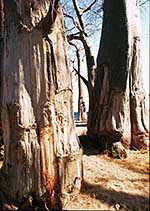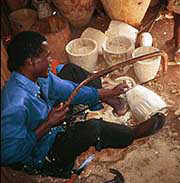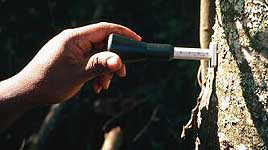 |
| Bark stripping
of the baobab (Adansonia
digitata Bombacaceae)
for making bark mats and
hats for sale in
Zimbabwe. © AB
Cunningham |
|
Africa
Regional Programme
The long-term goal of
this regional programme of the
People and Plants Initiative is
to achieve sustained plant
resource-sharing among poor rural
communities around sites of high
conservation value and high
land-use conflict in Africa. Two
of our main activities are aimed
at providing the
"tools" to achieve this
long-term goal : first, to
enhance capacity in selected
African countries (primarily
Uganda, Kenya, Tanzania and
Zimbabwe) for work with local
communities on conservation and
development issues related to the
use of wild plant resources. This
strengthens African capacity for
cross-disciplinary ethnobotanical
research related to resource
management and rural development.
Secondly, through the example of
local initiatives, help shape
national policies on conservation
and use of harvested plant
products.
|
This may involve the
resolution of resource conflicts, for
example through resource-sharing
agreements or the provision of
appropriate development alternatives. The
strong partnership between UNESCO and WWF
in our overall programme is exemplified
within the Africa programme, where the
two Regional Co-ordinators, Dr Robert
Hoeft (UNESCO) and Dr Tony Cunningham
(WWF) work closely together,
co-ordinating activities and in many
cases, co-funding or co-supervising
training courses or research students. We
believe that a strong geographic and
thematic focus gives strength (and more
depth) to the programme. We have also
taken a clear decision to avoid
duplication of effort. For this reason,
we work with existing national programmes
(such as the WWF Regional offices in East
and Southern Africa) on topics which have
been identified as local (or national)
priorities. In the second Phase of our
programme (1996-2000), our work focuses
on three major themes : bark use
(Zimbabwe), woodcarving (Kenya, southern
Uganda, Zimbabwe) and multiple-use as a
conflict resolution tool between the
local community and key forest
conservation areas (Bwindi Impenetrable
Forest in Uganda, Udzungwa Mountains in
Tanzania, coastal forests in Kenya,
Tanzania and Zanzibar, and montane
forests on Mt. Kenya).
 |
| Drum making has
important economic and
cultural benefits, but
commercial scale
production has depleted
large trees in lowland
forests in southern
Uganda. © AB Cunningham |
|
We currently
fund three Msc studies in East
Africa on the woodcarving theme
with a fourth MSc to be funded
this year in Zimbabwe. Two of
these studies are being done in
Uganda, where swamp forest
species are carved to make drums
and other musical instruments.
One of these studies, by Aisa
Samula, is on the dynamics of
trade, income, species and
volumes of timber involved and
the other, by Patrick Omeja, is
on the impact of this activity on
drum carving species. Both link
to the Uganda Forest Department
pilot project on collaborative
forest management at Mpanga
Forest. The third MSc, by Simon
Choge, registered at the
University of Natal (South
Africa) and doing fieldwork in
Kenya, focuses on a key policy
and local livelihoods issue : the
price/volume for different
woodcarving species, relating
this to stumpage fees,
alternative wood sources and
cultivation. |
The
Africa programme produces videos to illustrate research projects
and the methods used to better understand
and resolve specific conflicts between
people and plants conservation. These
videos bring several benefits to the
programme. First, they demonstrate the
value of applied ethnobotany to a much
wider audience. Secondly, they enable
young African researchers to talk
(through the video medium) to foresters,
protected area managers, resource users
or other young researchers in developing
countries. Thirdly, the videos are
produced at ten times less cost than by a
professional company, with better control
to ensure factual content. Fourthly, they
introduce others to written material
(manuals, key publications) by suggesting
extra reading at the end of the video.
Finally, the use of video to show applied
ethnobotanical projects reaches many more
people than publications, so forms a
useful tool in influencing people’s
opinions on issues.
Workshops, training
courses and studies funded through this
programme all have practical, positive
outcomes which can benefit rural farmers
and conservation. There is a high
potential, for example, of cultivating Prunus
africana – a medicinal species
which was the focus work we funded during
our first Phase – in the highlands
of East Africa (Kenya, Uganda) and West
Africa (Cameroon). At present, at least
3500 small scale farmers already do so.
Annual world demand of 3200 tons of this
species could be met by 75 000
small-scale farmers cultivating this
species in agroforestry systems.
Considering the high (200-300 people/km2)
population density of many African
highland areas this is not an unrealistic
goal. The Warburgia salutaris cultivation
project in Zimbabwe has similar
potential, but in response to local
markets - particularly in the area of
eastern Zimbabwe where it is locally
extinct.
 |
Measuring the thickness
of Prunus africana (Rosaceae)
bark in Cameroon. © AB
Cunningham |
We have
been supporting networking across the
language "divide" of English,
French and Portuguese speaking Africa by
supporting the formation of an African
ethnobotany network through AETFAT
(l'Association pour l'Etude Taxonomique
de la Flore d'Afrique Tropicale; the
Association for the Study of the Flora of
Tropical Africa). This is a pan-African
botany network which has been in
existence for over 30 years but, until
1997, had no associated ethnobotany
network. Through its Bulletins and meetings every 3 years, it
assists in disseminating information on
ethical issues or past or current
projects and literature and ideally,
coordination for fund raising.
The African
Ethnobotany Network
BACK
|